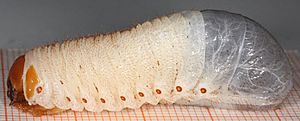Hermit beetle facts for kids
Quick facts for kids Hermit beetle |
|
|---|---|
 |
|
| Adult female | |
 |
|
| Larva | |
| Conservation status | |
| Scientific classification | |
| Kingdom: | |
| Phylum: | |
| Class: | |
| Order: | |
| Family: | |
| Genus: |
Osmoderma
|
| Species: |
O. eremita
|
| Binomial name | |
| Osmoderma eremita (Scopoli, 1763)
|
|
The Eremit beetle (scientific name: Osmoderma eremita) is a fascinating insect found across Europe. This dark-brown beetle has a shiny surface and can grow to be quite large, usually between 20 and 40 millimeters long (that's about the size of your thumb!). One of the most interesting things about the Eremit beetle is its unique smell, which some people say is like leather or even apricots!
These beetles love to live near old, decaying trees, especially in parks, along roadsides, and in old avenues. Sadly, because many old trees are being cut down, the number of Eremit beetles has been decreasing in many places where they used to live. This makes them an important species for conservation efforts.
Contents
What is an Eremit Beetle?
The Eremit beetle is a type of scarab beetle, which is a large family of beetles known for their sturdy bodies and often metallic colors. The Eremit beetle gets its name from the word "hermit," because it often lives a hidden life inside old trees. It's a bit shy and prefers to stay tucked away in its woody home.
Physical Features
Eremit beetles are easy to spot if you know what to look for. They are usually a deep, glossy brown color. Their bodies are quite robust, and they have strong legs that help them move around inside the decaying wood. Like all insects, they have six legs, a body divided into three main parts (head, thorax, and abdomen), and a hard outer shell called an exoskeleton.
Where Do They Live?
You can find Eremit beetles in many parts of Europe. However, they are not found in countries like the United Kingdom, Iceland, Ireland, Malta, Portugal, or San Marino. They prefer places with lots of old, mature trees, especially those that are starting to decay. This is because the decaying wood is crucial for their survival and the development of their young.
Life Cycle of the Eremit Beetle
The life of an Eremit beetle is quite long, especially the larval stage, which can last for several years! Understanding their life cycle helps us protect them.
Eggs and Larvae
The female Eremit beetle lays her eggs inside the decaying wood of old trees. Once the eggs hatch, tiny larvae (often called grubs) emerge. These larvae are soft-bodied and C-shaped, with strong jaws for chewing wood. They spend most of their lives, sometimes up to three or four years, munching on the decaying wood inside the tree. This process is important because it helps break down the wood, returning nutrients to the soil.
Pupation and Adults
After growing big enough, the larva builds a special chamber inside the wood where it transforms into a pupa. This is a resting stage where the larva changes into an adult beetle. After a few weeks or months, the adult Eremit beetle emerges. Adult beetles don't live very long, usually only a few weeks or months. Their main job is to find a mate and lay eggs, continuing the life cycle.
Why Are Eremit Beetles Important?
Eremit beetles play an important role in their ecosystem. They are what scientists call "saproxylic" insects, meaning they depend on dead or decaying wood.
Nature's Recyclers
By eating decaying wood, Eremit beetle larvae help break down old trees. This process releases nutrients back into the soil, which helps new plants grow. They are like nature's recycling crew! Without insects like the Eremit beetle, dead wood would pile up, and the forest floor wouldn't get the nutrients it needs.
Food Source
While they are busy recycling, Eremit beetles also become a food source for other animals, like birds and small mammals. This shows how every creature, big or small, fits into the complex web of life.
Conservation of the Eremit Beetle
The Eremit beetle is listed as "Near Threatened" by the International Union for Conservation of Nature (IUCN). This means their numbers are decreasing, and they could become endangered if we don't protect them.
Threats to Their Survival
The biggest threat to the Eremit beetle is the loss of their habitat. As old trees are cut down for development, farming, or safety reasons, these beetles lose their homes and food sources. They need very specific conditions – large, old, decaying trees – which are becoming rarer in many landscapes.
How We Can Help
Protecting the Eremit beetle means protecting old trees. Here are some ways people are trying to help:
- Protecting Old Forests: Setting aside areas of old-growth forest where trees are allowed to age and decay naturally.
- Leaving Dead Wood: In parks and managed forests, leaving some dead or decaying trees and logs can provide homes for these beetles and many other creatures.
- Planting New Trees: While new trees won't help the current generation of Eremit beetles, planting them now ensures there will be old trees for future generations of beetles.
By understanding and protecting creatures like the Eremit beetle, we help keep our natural world healthy and balanced.
See also
 In Spanish: Osmoderma eremita para niños
In Spanish: Osmoderma eremita para niños


